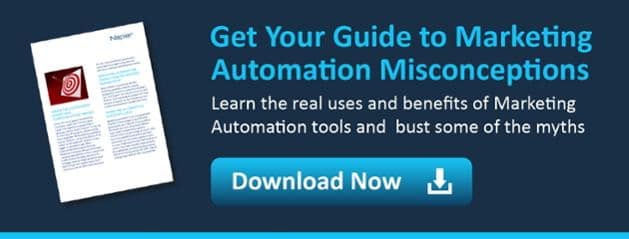Many marketers are interested in Marketing Automation and out of the questions we’re asked most often, the topic of Marketing Automation is always high on the list. From our discussions, its obvious that many people still don’t fully understand Marketing Automation (or have misconceptions) and are therefore not utilising it to it’s full potential and not seeing the results they were hoping for. To help, we have written an eBook to highlight the top marketing automation mistakes to avoid and dispel some of the most common myths. If you’re using automation software or are considering implementing an automation strategy, make sure you read our eBook which will be available later in the spring. For now, here’s the first chapter to get you started…
Marketing automation is designed to save time, help you automate previously manual tasks and improve your marketing efforts, but too many B2B companies are buying marketing automation software and not using it to its full potential. Marketing automation is not a lead generating machine, the results you get out of your software will only be as good as the time and content you put into it. Platforms such as Hubspot, Pardot, or Marketo can make your life easier by improving content delivery and personalisation, providing campaign reporting, qualifying leads for sales teams and much more.
Not understanding what you’ve bought
One reason for businesses not using marketing automation to the best of its abilities is that users do not fully understand the technology they have bought. Having bought the platform, they continue to use it in exactly the same way as they used their previous email marketing platform. Email marketing is a component of the platform, but marketing automation extends beyond basic email sending. Businesses that don’t plan to adapt their marketing strategy and utilise the full benefits of marketing automation, will not see the returns they had hoped for and subsequently may potentially feel disappointed and feel that the platform is to blame.
Not keeping your skills up
Many buyers of marketing automation software overlook the fact that it requires ongoing investment, it requires constant monitoring, fresh content, and optimisation through A/B testing. Just like visiting the gym you wouldn’t use the same two machines every visit and see the results of a full body workout, the same is true of your marketing automation platform -, you should explore every tool it has to offer for best results. With marketing automation, Email campaigns for example can be A/B tested in several ways such as, subject line, the time the email was sent (effecting people in different time zones), or what CTAs worked best, A/B testing can show you what is working (and what isn’t)- most standard email platforms can’t offer this which is one of many benefits that Marketing Automation offers.
Before buying any product you should do your research and find out which solution is going to work best for your company. Marketing automation software will always be improving by adding new features and functionality, so it’s important to learn how to use these tools to their full potential and maximise your investment. It’s easy to be overwhelmed with new software, so you should spend time familiarising yourself with what is new by asking your account manager questions and consistently training yourself by watching videos/tutorials, or reading educational blog content. Whilst new features are important, you can’t afford to forget the bigger picture by focussing on too many minor adjustments. It’s important to find a balance and spend time on the new features that will benefit you by helping to tailor your content specifically to your audience, equally well, not adapting regularly will be a waste of an opportunity.
Thinking that automation makes communication robotic
A common misconception about marketing automation, is that it makes your communication sound robotic and computerised, or that it creates the content for you. What marketing automation does do is deliver your content automatically, based on various triggers or criteria that you can set. Your database will then receive personalised and relevant content based on the individual contacts behaviour including website page visits and, form submissions. Marketing automation allows much more effective database segmentation where leads can be categorised by common behaviours, demographic details, specific interests and more.
Look out for our next chapter…in the meantime, why not download our guide to the most common Marketing Automation Misconceptions.
Author
-
Emily joins the Napier Team as a digital marketing apprentice, with the support of Chichester College. Emily recently completed her A-levels in Fine Art, Photography and English Language.
View all posts

